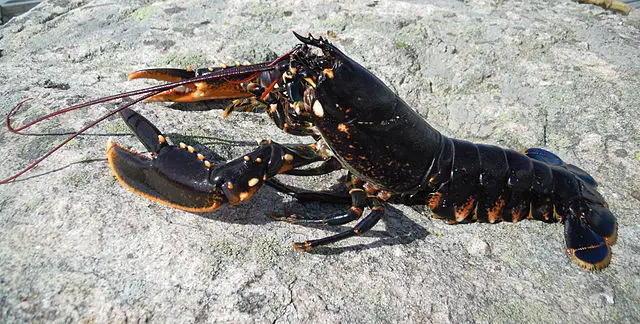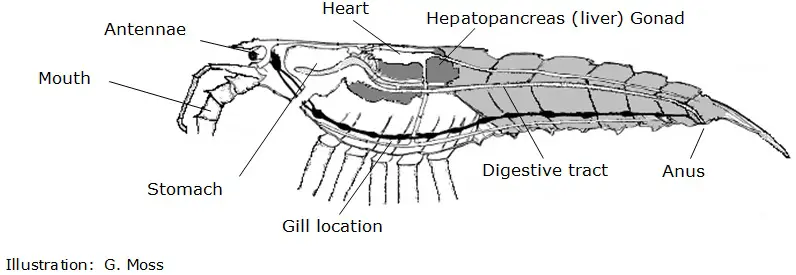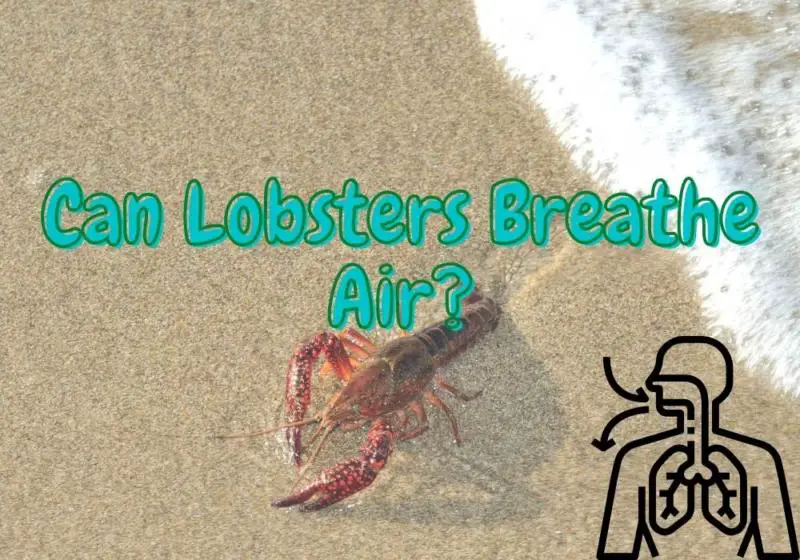Unlike crabs, some of which have adapted fully to a life on land, lobsters are deemed to a life underwater and cannot survive on land for extended periods of time.
Although lobsters rarely leave the water, their gills can absorb oxygen from air. While this absorption is inefficient, they can survive for a few days on land. However, their blood is much more efficient at binding oxygen compared to human blood.
When lobsters are removed from water, their gills clump together, reducing the surface area that can absorb oxygen5. On land, lobsters experience reduced oxygen uptake5 and reduced oxygen levels in their blood6 compared to when they are in the water.
This inefficient respiration will eventually make the lobster slow and drowsy and lead to the death of the lobster – if not by the lack of oxygen than the lack of energy to hunt for food.
Contents
Can Lobsters Survive on Land?
The lobster’s freshwater relative, the crayfish, is better adapted to spending time outside water and will sometimes leave water voluntarily. This behavior is rarely seen for lobsters, as they prefer their deep seawater home!
During times of drought, crayfish can travel small distances on land2 or burrow into the ground7 to find water. Burrowing crayfish can survive several days in their burrows7 where they mostly breathe air, since the water in their burrows has low oxygen levels8.
The European freshwater crayfish will emerge from water voluntarily to breathe air if their water source becomes low in oxygen9. The blood oxygen content of the European freshwater crayfish only decreases after 48 hours in the air and they can survive up to three days outside of water9.
Despite the lobster’s gills being inefficient at breathing air, and a significant drop in blood oxygen when they are removed from water to land, lobsters still manage to survive surprisingly long periods outside of water.

Photo by Arnstein Rønning.
Most amphibious species use more than one method to breathe. For example, frogs can breathe through their skin or with their lungs and crabs have a specialized gill lining that they can breathe with in addition to their gills3.
Howver, lobsters can only breathe through their gills, but they use other methods to survive emergence from the water. Lobsters usually become inactive when they are outside of water and disturbing them further decreases the oxygen levels in their blood4.
How long can a lobster stay underwater?
For as long as it likes – given that the water is clean, has the right salt concentration, and is properly aerated.
Most lobsters spend their entire life under the sea as they are entirely adapted to breathing underwater.
Inside their gill chamber, lobsters have feathery gills attached to the base of each leg1. Water enters the gill chamber through openings at the base of their legs and leaves through an opening close to their mouth2. Water is moved over the gills with a paddle-like respiratory appendage1.
Can Lobsters Drown?
Generally speaking, lobster cannot drown. However, they quickly suffocate in small amounts of water where aeration is bad. This is in contrast to crabs, which may be so well adapted to land that they cannot go back into the water for extended periods without drowning!
When kept in a container with water, oxygen needs to be replenished, either by replacing the water every hour or by using an air pump. Therefore, even though lobsters mainly live in water, it is easier to transport them in the air than in water.
When commercial fisheries need to transport lobsters over long distances, they are transported in air, either surrounded by ice or in refrigerated containers to keep them cool and moist.
The cool temperature allows them to become dormant, almost like they are hibernating, and reduces their need for oxygen3.
The gills of lobsters need to stay moist to absorb oxygen from the air. Providing they are not too close to their molting phase, where their blood’s ability to absorb oxygen is reduced, they can survive like this for a few days4.
After air exposure, it is important to allow lobsters time to recover in well-oxygenated water before exposing them to air again. Especially if they are stressed or have lost limbs during transport.
For example, the common practice of placing lobsters in oxygenated seawater before transporting them long distances improves their chances of survival4.
This practice allows them to recover from the time they were exposed to air on the fishing vessel.
Do Lobsters Have Blood?
Yes, but it is not likely to be what you associate with blood.
Lobster blood is different from ours because they have a copper-based protein, instead of an iron-based protein like the hemoglobin in humans, to carry oxygen10.
The copper-based protein is not carried inside a red blood cell, like in our blood. Instead, they are freely dissolved in the blood.
In contrast to humans, lobsters’ blood is especially adapted to survive periods of low oxygen availability.
When humans face low-oxygen conditions, CO2 quickly builds up in our blood and reduces our ability to absorb oxygen3.
Lobsters’ blood, however, becomes more effective at binding oxygen when they face low-oxygen conditions4.
What color is lobster blood?
Because of the copper in their blood, lobster blood, just like crab blood, is usually colorless but turns blue when it is exposed to oxygen11. However, lobsters have an additional pigment in their blood, which gives it a pinkish hue, and makes it less blue than crab blood11.
If you’re interested, watch this video of a scientist drawing blood from a lobster to measure its blood sugar levels.
Do Lobsters Have Hearts?
Yes, lobsters have a muscular, single-chambered heart and a few arteries, but they have no veins to transport the blood back into their heart1.
This is called an open circulatory system. This system is one of the most primitive circulatory systems and is also used by other crustaceans, insects and many mollusks.
This is even more primitive than the two-chamber heart of snakes and lizards.
Instead of having their blood transported to and from their organs through a complex system of arteries and veins like in humans, their blood lies in direct contact with their organs and blood enters the heart through three pairs of openings1.
These openings have valves that open to suck in blood and close when the heart contracts to pump blood out through the arteries1,12.
One-way valves between the heart and the arteries prevent blood from returning to the heart after it is pumped out12. The arteries distribute the oxygen-rich blood to all the organs in the body.

Oxygen-depleted blood flows via channels through the gills to get oxygenated. After leaving the gills, blood collects in a cavity around the heart from where it gets sucked into the heart again12.
The simplicity of this circulatory system also allows easier reconstruction when the lobster regenerates lost limbs.
Conclusion
Lobster circulatory systems used to be considered inferior compared to of humans. It turns out, however, that they are perfectly adapted to surviving in their environment.
They are one of the few animals, alongside crabs and crayfish, who can breathe both inside and outside of water.
Their copper-based blood allows them to survive periods of low oxygen conditions that humans could never survive.
The gills used by lobsters are analogous to those of octopi, squids, crabs, and crayfish, which I have also written about, so check out those posts if you’re interested!
Sources:
- Hickman CP, Kats LB. 2006. Laboratory studies in integrated principles of zoology. McGraw-Hill New York, NY, USA. 436 pp.
- McMahon BR and Wilkes PRH. 1983. Emergence responses and aerial ventilation in normoxic and hypoxic crayfish Orconectes rusticus. Physiological Zoology. 56 (2): 133-141.
- Schmidt-Nielsen K. 1997. Animal Physiology. Cambridge Press. New York, NY, USA. 612 pp.
- Whiteley NM and Taylor EW. 1992. Oxygen and acid-base disturbances in the hemolymph of the lobster Homarus gammarus during commercial transport and storage. 12 (1): 19-30.
- Taylor HH and Waldron FM. 1997. Respiratory responses to air-exposure in the southern rock lobster; Jasus edwardsii (Hutton) (Decapoda: Palinuridae). Marine and Freshwater Research. 48: 889-897.
- Taylor EW and Whitely NM. 1989. Oxygen transport and acid-base balance in the haemolymph of the lobster, Homarus gammarus, during aerial exposure and resubmersion. Journal of Experimental Biology. 144: 417-436.
- Kouba A, Tikal J, Cisar P, Fort M, Priborsky J, Patoka J, Buric M. 2016. The significance of droughts for hyporheic dwellers: Evidence from freshwater crayfish. Scientific Reports. 6: 26569.
- McMahon BR. 2001. Respiratory and circulatory compensation to hypoxia in crustaceans. Respiration Physiology. 128: 349-364.
- Taylor EW and Wheatly MG. 1981. The effect of long-term aerial exposure on heart rate, ventilation, respiratory gas exchange and acid-base status in the crayfish Austropotamobius pallipes. Journal of Experimental Biology. 92: 109-124.
- Senozan NM. 1976. Hemocyanin: The copper blood. Journal of Chemical Education. 53 (11): 684 – 688.
- Redfield AC. 1930. The absorption spectra of some blood and solutions containing hemocyanin. Biological Bulletin. 58 (2): 150-175.
- McMahon BR and Burnett LE. 1990. The crustacean open circulatory system: a reexamination. Physiological Zoology. 63 (1): 35-71.





